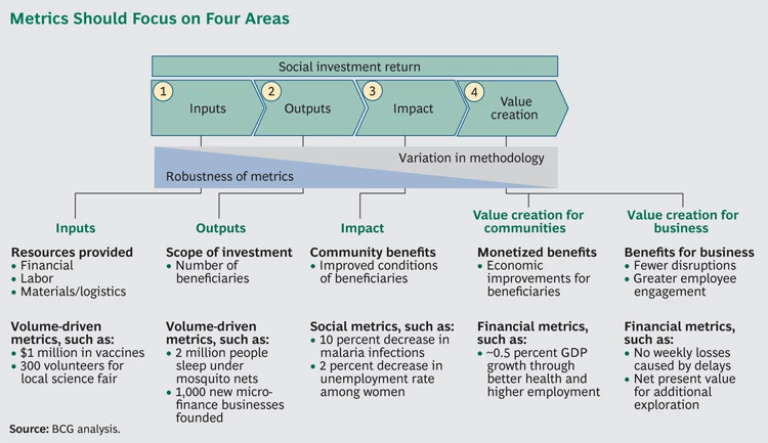Companies in the natural-resources industry are well aware of the economic, social, and environmental impact they have on the communities in which they work because of the invasive nature and massive scale of their operations. Besides technical and geological risks, companies in the industry—which includes the mining, oil and gas, water, agriculture, lumber, and other energy-related sectors—face a wide range of social and government risks, such as local protests, work stoppages, regulatory and tax changes, and nationalization, that can disrupt operations or halt them entirely. Taken together, these factors make it necessary for companies to turn community engagement into a core part of their business strategy.
Community engagement activities typically address local issues related to education, health care, poverty, hunger, and infrastructure. Starbucks, for instance, is committed to increasing access to education and training in the communities that produce its coffee, tea, and cocoa. Xstrata, the global mining company, seeks to preserve biodiversity in Australasia and protect human rights in Colombia. Chevron has made the elimination of mother-to-child HIV transmission in Angola, Nigeria, and South Africa a top priority. While improving the quality of life in the community, outreach efforts such as these make good business sense and are often critical to a company’s success—and to maintaining its social license to operate. Oil and natural gas, for instance, require long-term investments in exploration and production that can span more than 30 years. Building a strong legacy and positive reputation with host governments, suppliers, the local workforce, the community “on the other side of the fence,” and other key stakeholders is a critical part of doing business.
Despite the clear business and social benefits of these efforts, the natural-resources industry as a whole spends only about 0.5 to 1 percent of its pretax earnings on community engagement, compared with up to 1.5 percent for many other industries—such as health care and consumer products. (The absolute dollar amount is relatively high, however, because of the overall profitability of the natural-resources industry—especially the oil and gas sector.) The reasons for this lower rate of investment are varied. Many companies aren’t clear about the strategic value of these initiatives. Others want to avoid the appearance of buying favor with local governments, and their outreach efforts may be fragmented or difficult to measure. Still, the total amount or percentage budgeted is less critical than the impact that such investments deliver. Even the most well-intended and well-funded programs can fall short if they lack focus or the skills necessary to address local needs effectively.
To be effective and create value for the community and the company, community engagement should be as integral to the business as accounting or human resources and should include specific processes, structures, metrics, and skilled staff. With a professional approach, companies can deliver more value with the resources they invest and make a lasting contribution to the quality of life in their host countries.
Planning for Success
Community engagement is the process of working collaboratively with local groups and social organizations to address key issues that affect the well-being of the community. Since natural-resources companies require temporary or permanent access to land where local people are living and working, community education and outreach efforts are critical to a sustainable relationship. Companies that undertake these initiatives have the greatest impact when they maintain a clear strategic focus and build ongoing relationships with a select group of established local or global nonprofits rather than spreading resources too thin.
For instance, Chevron partners with Baylor College of Medicine and the Baylor International Pediatric AIDS Initiative at Texas Children’s Hospital, the largest university-based program in the world dedicated to improving the lives of HIV-infected children. Choosing the right partners is so critical that some companies invest in building the capabilities of the nonprofit organizations they work with to help maximize value creation.
Our global community-engagement work has led us to identify six determinants of success.
Setting Clear Objectives. Some objectives will be pragmatic, designed to support the needs of the business. Companies that have to hire local people, for instance, might set up training programs to educate potential workers on the technical, safety, and operational aspects of the business. Other objectives will support the social-investment strategy, based on an initial-needs analysis. Objectives must be clearly defined, with milestones, time frames, and endpoints. The key is to deliver greater impact by focusing efforts on a few issues and partner organizations and avoiding a scattered, shotgun approach. A growing number of companies are realizing the importance of having a “triple bottom line” comprising profit, people, and the planet. This approach, created by corporate-responsibility expert John Elkington in the 1990s, measures the financial, social, and environmental performance of a company over a period of time—and considers the full cost of doing business.
Assessing Local and Global Needs. The front end of any effort requires a detailed social-impact assessment to identify the relevant stakeholders and their specific needs. Are there health or environmental issues that affect the quality of life in the community? Which needs are the most pressing, and which are currently unaddressed or underserved? Every community has competing interests—and the voices of some advocates may be louder than others. The social-impact and stakeholder assessment helps to identify the most critical needs and enables a company to choose where to focus.
For instance, as a major employer and investor in Africa, Chevron focuses on HIV/AIDS testing and prevention, helping to reduce the risk of mother-to-child transmission. Chevron clinicians educate employees, establishing a culture that encourages testing and treatment, fights the stigma of HIV, and provides comprehensive medical care for employees and their dependents. The program is succeeding: for 7 years in Angola and 11 years in Nigeria, Chevron has had no reports of mother-to-child HIV transmission among its employees or their qualified dependents, and the impact has spread to surrounding communities.
Defining Metrics of Success. Although some outcomes will be intangible or difficult to evaluate, clear metrics can help quantify the impact of outreach initiatives. The most effective metrics focus on four areas: inputs, outputs, impact, and value creation. (See the exhibit.) Output metrics—such as how many more local children got access to education, or how many people were vaccinated against a disease—are highly comparable across time, sites, and companies. Impact for the business could be measured by how much worker absentee rates were reduced, or how much faster positions were filled with qualified workers. At the back end, a monitoring and evaluation process can help make the activities more effective and efficient by prioritizing social and business returns. Clearly identifying the impact on the community and the business also shows the value of the efforts to the company and its shareholders—and the need for continued investment.
Bringing in the Right People. Far from being a dumping ground for low performers or failed engineers, community engagement work must be done by professionals with very specific skills—both hard and soft. The work is highly demanding. Community engagement advisors require a wide range of capabilities and expertise—everything from strategic thinking and business acumen to social skills and project management abilities. On-the-job training programs can supplement the capabilities of potential community-engagement advisors. For instance, employees with a technical background can develop their skills in cultural sensitivity and social service. Similarly, new hires with a strong background in social services may need to learn skills related to business and strategic thinking.
Standardizing Processes and Sharing Best Practices. Although a company’s community-engagement efforts are often spread out across the globe, they typically involve the same processes wherever they take place: social-investment planning, budgeting, project selection and management, priority setting, impact assessment, communication, crisis management, and resettlements as required. These processes may need to be adapted to local needs, but standardizing them and sharing best practices across the organization can greatly improve effectiveness, efficiency, and the consistency and quality of service delivery as companies move up the learning curve.
Communicating Results. It is important to recognize and honor community engagement efforts and the real difference they can make. Internal corporate-communications efforts raise awareness of the social impact the company is having, which strengthens employee engagement, pride, and loyalty. External communication initiatives are most effective when integrated with a company’s public-affairs and government-affairs organizations, since the people involved in these efforts are usually not PR professionals. Sharing the success of engagement efforts externally helps to establish the company as a long-term partner with a vested interest in the community. In the past, companies were sometimes reluctant to publicize their community activities because of concerns that they would be perceived as an extension of marketing. The growing importance of corporate social responsibility has made businesses realize the strategic importance of effective communications.
Community engagement comes in many forms. It can include partnerships with global social organizations; construction and maintenance of infrastructure, such as roads, hospitals, and schools; training and educational efforts; or disaster relief. But whatever form it takes, the goal of these efforts for all natural-resources companies is the same: to make a lasting improvement in the quality of life of the communities in which they work. Our six determinants of success will ensure that a company’s community-engagement efforts are as well planned, supported, and effective as every other strategically critical area of the business.









